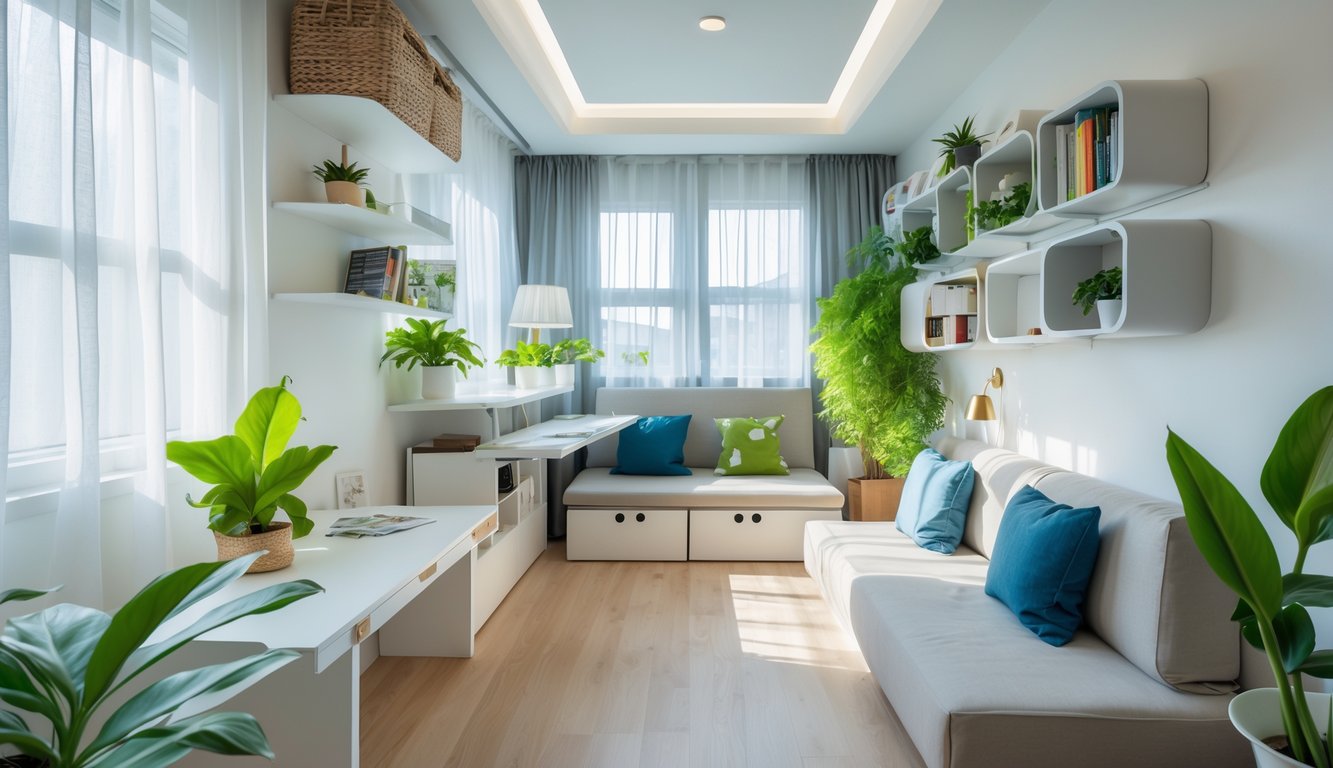
Innovative Furniture Ideas Transforming Small Spaces
Futons always fold weird, don’t they? Every time I sit, it’s like a trust fall. Trying to cram a bed, desk, and storage into 200 square feet is a joke—unless you stumble on those weirdly clever furniture hacks. Forget “statement” pieces; I want stuff that actually works, even if it comes with a 50-page assembly booklet.
Multi-Functional & Multifunctional Furniture
Apparently, every coffee table is now a storage box, a dinner table, and a bench. Why do they call everything “multi-functional”? Marketing, probably, but sometimes it’s legit. I saw an IKEA Stuva bench with drawers and a fold-out tray—tried to build it, got the drawers upside down. Not my finest hour.
Transformer couches, ottomans, shelving units—they claim to save 20% of your space. Good Housekeeping said so in 2024. Does it feel bigger? Not really, but at least I’m not tripping over stuff. Drop-leaf tables are ugly but your vacuum fits under them. Modular shelving means more dusting but less chaos.
Realtors keep pushing “room-in-a-box” sets. Most people forget the ottoman is a file cabinet. No influencer video will warn you about the hydraulic hinges that snap shut on your cat’s tail, though.
Finding the Perfect Murphy Beds
Murphy beds still scare me. My friend has a scar from a 2022 model with a “sensitive latch.” But they do free up real space—Apartment Therapy says up to 30 square feet. Even The New York Times gave them a reluctant thumbs-up.
Once you install one, you get a living room and a bedroom in a space smaller than most closets. The cheap ones sag, and the mattress costs more than the frame. Some come with built-in shelves or desks, but assembly is a pain—bring a torque wrench and a friend.
One architect told me custom Murphy beds are worth it for places under 400 square feet. You pick where the storage goes, which way it folds, even the finish (skip oak veneer, it’s overrated). Heads up: some fire codes ban them near radiators. Almost learned that the hard way.
Compact Desks and Workstations
Honestly, my kitchen table is a lost cause at this point—two years as a “workstation” and now it’s got a permanent limp. Why is every “compact” desk now some kind of puzzle? The Branch standing desk (24″ deep, minimum) gets raved about on the Wirecutter Slack, like it’s a secret handshake or something. I mean, it’s fine, but I’m not mounting a foldout desk on my wall unless my landlord’s drywall can handle a small elephant. Learned that the hard way.
There’s a whole industry for vertical workstations now—stacked shelves, “maximizing airspace” (that’s a real quote, I can’t make it up). Works great until you smack your head and curse your life. I once made a rolling desk that slid under my bed—cable chaos, don’t recommend, but if you find one with legs that actually retract, just grab it. Those bookshelf desks that vanish into your shelving? They’re always sold out by October, and honestly, I get why.
Standing desks get hyped to the moon, but try finding one that fits in a shoebox apartment. If you’re short (like me), a desktop riser works better anyway, and if it doubles as a breakfast tray, that’s a win. Keyboard trays that swing sideways—not just straight out—saved me from late-night toe injuries. Supposedly they’re fine for posture, and my chiropractor hasn’t scolded me yet, so I’ll take it.
Designing with Light for Open, Airy Spaces
Okay, so who actually believes opening a window facing a brick wall will make a closet feel “bigger”? That’s delusional. I’ve tried about forty paint swatches—so much white my eyes hurt—and my room still looked like a dim shoebox until I finally got some basics right. “Let the light in,” they say, but what if your apartment eats daylight for breakfast and spits out darkness by noon? Happens.
Making the Most of Natural Light
Still makes me nuts: why do people block windows with furniture? I moved my bookcase and the whole space brightened up (cat hated me for a week, not my problem). Dr. Alice Lee—Compact Living’s resident expert—claims that putting shiny stuff perpendicular to windows can boost sunlight by 23%. Sure, that’s oddly precise, but whatever, I’ll take free light.
Heavy curtains. Why? Sheer drapes like IKEA’s LILL: cheap, washable, and actually let light through. Window film? Meh. It helps with glare, but don’t expect miracles. Plants hog light too, but at least they don’t whine about the view. And if your “natural light” is just car headlights, buy a daylight bulb and stop pretending you’re above artificial lighting.
Incorporating Light Colors
Not all white paint is created equal—my living room’s “Antique White” turned yellow every afternoon. Color temperature is a scam, I swear. Pros push whites, grays, pastels, etc., for a reason, but I once painted a hallway “Decorator’s White” and it looked like a hospital. Test everything, everywhere.
I read somewhere (Martha Stewart, maybe?) that white or off-white walls bounce up to 90% of light, while dark colors swallow it whole. Sounds fake but checks out—my friend’s navy rug turned her hallway into a cave. Ceilings: matte white works, but eggshell bounces more light (and, unfortunately, every ceiling flaw). No guest ever notices except me, but it still bugs me.
Utilizing Mirrored Closet Doors
Mirrored closet doors get a bad rap—everyone thinks 80s suburbia. But realtors and stagers love them because they make rooms look massive. MirrorWorks claims a “40% bigger” effect, which is probably made up, but I can’t argue with results. Downsides: fingerprints, accidental dance breaks, and don’t even try to hang hooks. I swapped my bifold doors for mirrored sliders on my IKEA PAX and it’s blindingly bright in the mornings. My brother said it looked “fake big.” I call that a win. If you’re worried about privacy, slap on some decals—problem solved.



